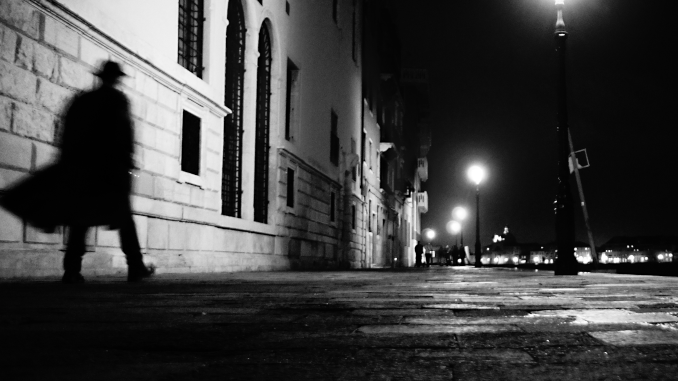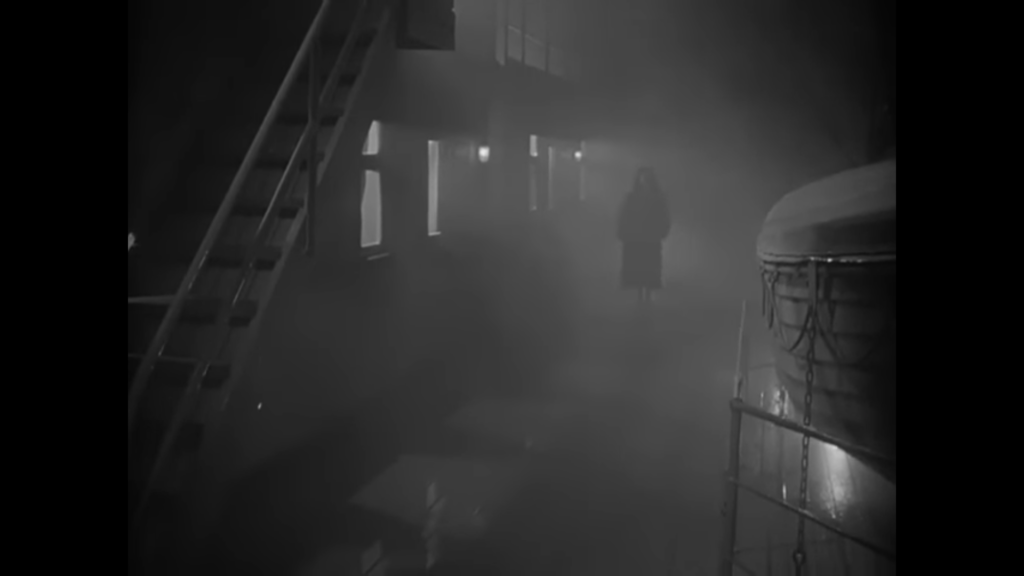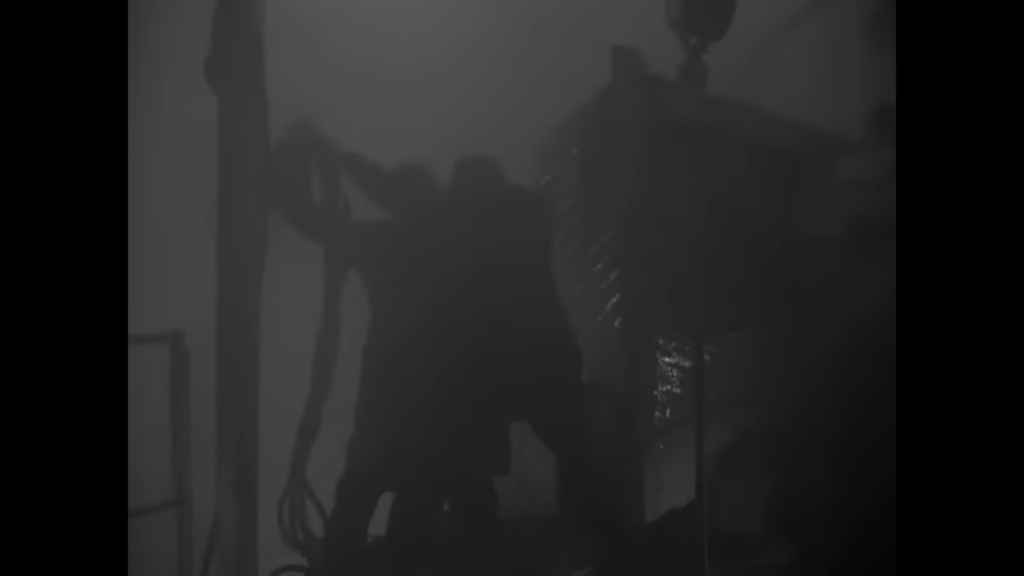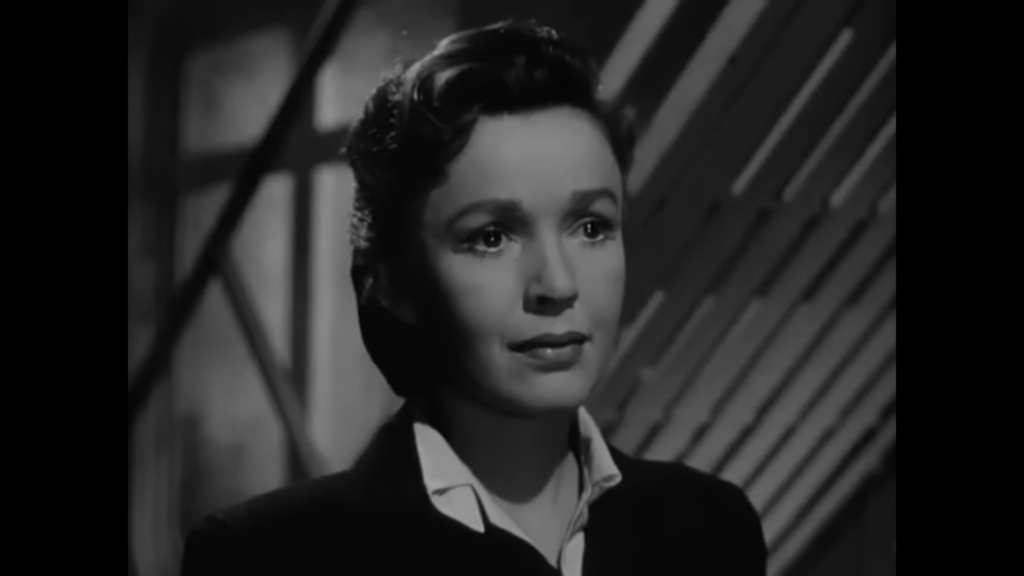
Welcome to a discussion of the Women of Noir! Today’s topic is “The Woman in Distress,” and our film is 1953’s “Dangerous Crossing,” starring Jeanne Crain (Ruth Stanton Bowman), Michael Rennie (Dr. Paul Manning), Max Showalter (Jim Logan), Carl Betz (John Bowman/Jack Barlowe), Mary Anderson (Anna Quinn), Marjorie Hoshelle (Kay Prentiss), and Willis Bouchey (Captain Peters). Directed by Joseph M. Newman; cinematography by Joseph LaShelle. Produced by Robert Bassler for 20th Century Fox. Screenplay by Leo Townsend; based on the radio play “Cabin B-13” by John Dickson Carr.
“The Woman in Distress” is a typical literary trope, creating the reason for a story to be set into motion: there’s a girl in trouble somewhere, and she needs assistance. Sometimes in noir films, as well as more often in other genres of the period, this character is a minor one. (The Carmen Sternwood character in “The Big Sleep” is one such; the Janet Stewart character in “Shock” is another.) But sometimes in noir, the WinD is the central character; the plot isn’t simply driven by her plight, she’s in the bulk of scenes, carrying the story forward. In noir the WinD tends to be more self-reliant and is often actively trying to get herself out of trouble. (This film is such a case in point, as well as Julia in “My Name Is Julia Ross.”) Sometimes the WinD is being driven mad for some nefarious purpose, with the baddie’s ultimate goal being a tragic end for our heroine (as in “My Name Is Julia Ross,” and “Gaslight.”); in other instances, she’s just a woman who got caught up in a bad situation that she’s trying to get out of (the mother/daughter pair in “The Reckless Moment” is a good example of this; another would be Ellen Jones, who spends most of the film trying to retrieve an incriminating letter in “Cause for Alarm!”).
In the case of today’s film, after a whirlwind romance, Ruth Bowman and her husband John arrive aboard a transatlantic ocean liner. Once they settle into their cabin, John suggests he needs to leave some money with the ship’s purser and he’ll meet her afterward in the main lounge. Ruth waits for some time, but finally becomes anxious that John hasn’t turned up; so she goes off in search of him, but fails to find him. She ends up at their cabin (B-16), knocking on the door and begging John to let her in. A steward notices her and lets her into B-16, even though he knows it wasn’t booked for this voyage and is empty. Ruth is now confused, since this was the room she’d been in earlier, only now all the luggage, fruit, and flowers are gone. The steward tells her she’s in B-18 and takes her there. All her luggage is in the room, but John’s isn’t. It’s at this point that the steward and others on the ship insist she boarded alone and is registered under her maiden name of Stanton. Thus Ruth’s search for her husband begins.
Here’s today’s film, if you want to watch and discuss it in the comments below:
They pack a lot into the 75 minutes of this movie!
The scenes most indicative of film noir are the foggy night scenes up on the ship’s deck. It’s as if the fog is a metaphor for the secrets Ruth is trying to uncover, as she and others emerge and disappear into the mist.


This also features possibly the unlikeliest looking lethal woman…

I also liked this shot because of all the railings and shadows they’re casting on the background wall.
Overall, this is an enjoyable film. Not great, by any means, but a good, solid story. I give it 3 unfiltered cigarette puffs out of 5.
Next week we’ll be looking at “The Femme Fatale” in a film called “Blonde Ice.” If you do a search on YouTube for “Blonde Ice full movie” you’ll find plenty of links to it. Until next week, stay out of the fog!
As always, this is an open thread, so feel free to discuss whatever you like in the comments below.

1 Trackback / Pingback
Comments are closed.